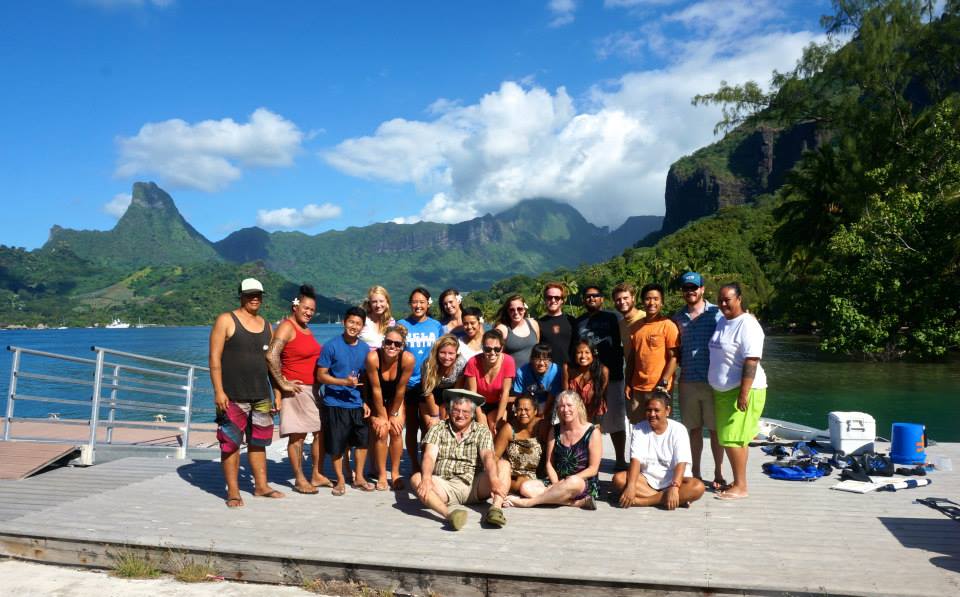Students immerse into research with Marine Biology Quarter

Students in the marine biology research quarter this school year travelled to Moorea, French Polynesia to conduct research. (Courtesy of Lilah Hubbard)
By Ariana Ricarte
June 9, 2014 12:00 a.m.
Covered head to foot in diving gear, Brian Dang recalled the techniques he learned in his first scuba lessons at the Student Activities Center Pool as he plunged straight into the clear waters in Moorea, French Polynesia.
The third-year biology student clipped pieces of algae for data collection and swam alongside giant sea turtles and 10-foot-long sharks – an unusual environment for a research course at UCLA.
The field and marine biology quarters, which are part of the curriculum in the ecology and evolutionary biology department, give selected students the opportunity to travel abroad with professors and gain hands-on research experience. Students participating in the Field Biology Quarter traveled during winter, while students focusing on the Marine Biology Quarter took the course in the spring this year.
Students are selected based on an essay and interview process, said Daniel Blumstein, the department chair and one of the instructors of the course.
Students who participated in this year’s program collectively completed about 20 projects across two quarters, using data gathered from Moorea.
“I like to say that students are consumers of knowledge, but when they finish this program, they become producers of knowledge,” Blumstein said. “The whole experience is very transformative for them.”
The field and marine biology quarters have been a part of the life science curriculum since the 1970s, Blumstein said.
UCLA students and faculty have traveled to places like Nicaragua, Australia and Thailand in the past. There are also local field quarters where students gather data from California national reserves.
Each course location changes depending on the professors’ preference, Blumstein said. He added that they chose Moorea this year because of its coral reefs and location outside of the Caribbean hurricane belt.
Students in the evolution, ecology and behavior major are required to participate in a field or marine biology quarter, but the application is open to all students.
Through the program, students are exposed to the lifestyle associated with their research. A few weeks before the students leave the country, they take daylong classes with their professors about field research techniques and the culture of the country they plan to visit.
“This experience is different from teaching in a classroom because I can also learn and discover with the students,” Blumstein said.
To participate in the Marine Biology Quarter, students must apply a year in advance. Once accepted, they begin a two-quarterlong scuba diving training course.
In addition to lessons in the Student Activities Center, the students practiced diving near beaches in Malibu and Catalina Island until they became certified scientific divers, Dang said.
He added that when the Marine Biology Quarter students went to Catalina Island, they needed to perform 12 scientific dives to move up another level for their certification.
Students typically spend a few weeks gathering data on location and later return to UCLA to analyze the information and write a final research paper.
They also have the option to further refine their research papers after the class is over and submit it to a scientific journal for publication.
About 75 percent of students’ projects from the course have previously been published in journals such as Animal Behaviour and Behavioral Ecology, Blumstein said.
Lilah Hubbard, a fourth-year ecology, behavior and evolution student, completed her second Field Biology Quarter during winter.
“In a normal class, you sit there and you just learn the concepts behind research,” Hubbard said. “Being able to go out into the field and actually do it gave me the skills I’ll need later.”
Hubbard said she hopes to work as a research assistant and later apply to a graduate school in some field of biology in the future.
While in Moorea, Hubbard and her team of two other students studied the effect of background noises on myna birds’ ability to hear predators.
They walked to different grassy areas of the island and observed the birds’ behavior after playing a variety of distracting sounds, like a motorcycle engine or different bird calls. When she and her teammates arrived at UCLA, she said they found that their results were the exact opposite of their predictions.
At first, they had hypothesized that the sounds would decrease the birds’ ability to respond to predators, but their data suggested that the birds’ ability was enhanced.
“You learn that this is what research is like on a day-to-day basis,” Hubbard said. “It’s about learning how to be flexible about certain situations.”
Hubbard and her teammates are currently in the process of finalizing the research paper to submit it to a science journal.
Dang, who participated in the Moorea trip, observed different species of fish and drew samples algae for his projects.
He said his participation in the Marine Biology Quarter confirmed that he wanted to pursue his interests in medicine and nature after graduation. He said he hopes to obtain a doctorate in marine pharmacology as well as become a physician.
“A lot of people do research, but in a sense, their specimens have already been collected for them,” Dang said. “With this program, you get a rare behind-the-scenes look at what grad school might be like.”


